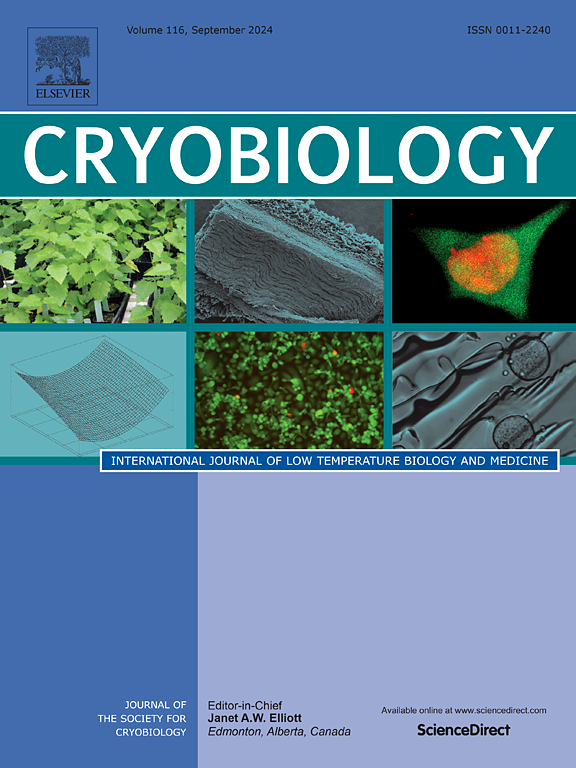Interrupted slow cooling of mouse cardiac endothelial cell monolayers
IF 2.1
3区 生物学
Q2 BIOLOGY
引用次数: 0
Abstract
The increasing evidence of the role of the endothelium in cardiac physiology and the importance of a functional endothelium for vascular grafts necessitate in vitro models for research. Cryopreservation of cardiac endothelial cell monolayers will enable their on-demand availability. Here, we used interrupted slow cooling (graded freezing) to characterize the cryobiological response of a mouse cardiac endothelial cell (MCEC) line in a monolayer format and describe a procedure for its successful cryopreservation. MCEC monolayers on fibronectin-coated coverslips made of Rinzl, whose coefficient of thermal expansion is matched to ice, were equilibrated at −5 °C, ice-nucleated, cooled at 1 °C/min, and at various temperatures during cooling, samples were either directly-thawed or plunged into liquid nitrogen and then thawed. In the absence of cryoprotectants, direct-thaw samples revealed cryoinjury from solute effects, while plunge-thaw samples revealed damage from intracellular ice formation. MCEC monolayers were then loaded with 5 % dimethyl sulfoxide (Me2SO), 6 % hydroxyethyl starch (HES), and 2 % chondroitin sulfate (CS) prior to interrupted slow cooling. The maximum immediate post-thaw relative viability (93.7 ± 5.5 %) and absolute viability (95.5 ± 21.1 %) were attained after plunge from −40 °C. Both fresh and cryopreserved MCEC monolayers exhibited metabolic activity, angiogenic potential through tube formation on Matrigel, intracellular calcium signaling, and expression of the tight junction protein ZO-1. Viability and functional assessments after post-thaw overnight culture did not show delayed-onset cryoinjury. Thus, the combination of Me2SO, HES, CS, and Rinzl substrate resulted in viable and functional MCEC monolayers post thaw. This cryopreservation protocol will allow accessibility of cardiac endothelial monolayers for use in studying cardiac physiology, cardiovascular disease modeling, and drug-induced cardiotoxicity testing.
中断缓慢冷却小鼠心脏内皮细胞单层
越来越多的证据表明内皮在心脏生理中的作用以及内皮功能对血管移植的重要性需要体外模型进行研究。心脏内皮细胞单层的低温保存将使其按需可用。在这里,我们使用中断缓慢冷却(分级冷冻)来表征单层小鼠心脏内皮细胞(MCEC)系的低温生物学反应,并描述了其成功低温保存的过程。热膨胀系数与冰相匹配的Rinzl制成的纤维连接蛋白涂层盖盖上的MCEC单层,在- 5℃下平衡,冰核,1℃/min冷却,在冷却过程中的不同温度下,样品直接解冻或浸入液氮中再解冻。在没有冷冻保护剂的情况下,直接解冻样品显示溶质效应造成的冷冻损伤,而骤降解冻样品显示细胞内冰形成造成的损伤。然后将MCEC单层加载5%二甲亚砜(Me2SO), 6%羟乙基淀粉(HES)和2%硫酸软骨素(CS),然后中断缓慢冷却。从- 40°C骤降后,解冻后立即相对活力(93.7±5.5%)和绝对活力(95.5±21.1%)达到最大。新鲜和冷冻保存的MCEC单层均表现出代谢活性、血管生成潜力(通过在基质上形成管)、细胞内钙信号传导和紧密连接蛋白ZO-1的表达。解冻后过夜培养后的活力和功能评估未显示迟发性冷冻损伤。因此,Me2SO、HES、CS和Rinzl底物的结合在解冻后产生了具有活性和功能的MCEC单层。这种低温保存方案将允许心脏内皮单层用于心脏生理学研究、心血管疾病建模和药物诱导的心脏毒性测试。
本文章由计算机程序翻译,如有差异,请以英文原文为准。
求助全文
约1分钟内获得全文
求助全文
来源期刊

Cryobiology
生物-生理学
CiteScore
5.40
自引率
7.40%
发文量
71
审稿时长
56 days
期刊介绍:
Cryobiology: International Journal of Low Temperature Biology and Medicine publishes research articles on all aspects of low temperature biology and medicine.
Research Areas include:
• Cryoprotective additives and their pharmacological actions
• Cryosurgery
• Freeze-drying
• Freezing
• Frost hardiness in plants
• Hibernation
• Hypothermia
• Medical applications of reduced temperature
• Perfusion of organs
• All pertinent methodologies
Cryobiology is the official journal of the Society for Cryobiology.
 求助内容:
求助内容: 应助结果提醒方式:
应助结果提醒方式:


